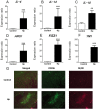Regulation of type 2 diabetes by helminth-induced Th2 immune response
- PMID: 27665994
- PMCID: PMC5240765
- DOI: 10.1292/jvms.16-0183
Regulation of type 2 diabetes by helminth-induced Th2 immune response
Abstract
Helminth-induced type 2 cytokines increase the number of regulatory T cells and alternatively activated macrophages, resulting in modulation of the host-immune system. Studies on these parasite-induced immunoregulatory mechanisms might contribute to the development of new therapies for inflammatory diseases, including type 2 diabetes (T2D). Previous studies have suggested that progression of obesity-associated metabolic abnormalities is under pathophysiological control of CD4+ T cells. Glucose absorption through the intestinal epithelium reduced after infection in a STAT-6-dependent manner. In this study, we investigated whether infection with the gastrointestinal nematode parasite Heligmosomoides polygyrus (Hp) can modulate T2D-associated pathology in a mouse model (KK-Ay/TaJcl). KK-Ay/TaJcl mice were inoculated with infective third-stage Hp larvae and studied at Day 8 following infection. Uninfected KK-Ay/TaJcl mice showed high blood glucose levels even 120 min after administration of glucose by IP injection. However, it was significantly improved in the infected group. HOMA-IR, fat accumulation and FAS gene expression in the liver were significantly decreased by Hp infection. GLUT2 gene expression in this group was significantly lower than that in the uninfected diabetic mice, which might be related to the decrease in glucose absorption in the parasite-infected intestine. In conclusion, helminth-induced type 2 immune responses might contribute to T2D disease control.
Figures





References
-
- Folch J., Lees M., Sloane Stanley G. H.1957. A simple method for the isolation and purification of total lipides from animal tissues. J. Biol. Chem. 226: 497–509. - PubMed
MeSH terms
Substances
LinkOut - more resources
Full Text Sources
Other Literature Sources
Medical
Research Materials
Miscellaneous

